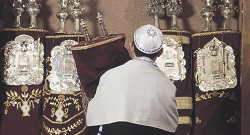
Anyone who sees young children in “dress-up” clothes knows that a magical transformation has taken place. They no longer use their normal voices, and even the shyest child can suddenly exude personality. In fact, they are no longer their regular selves at all, but have thoroughly become a superhero, a cowboy, a doctor, a princess.
I vividly remember one student on Purim who sat in a corner crying: "Don't call me Benjamin — my name is Batman!" The simple act of putting on a special piece of clothing can change attitude, outlook, and persona.
We might attribute this behavior to the wonderfully vivid imagination of preschoolers, but our Torah portion seems to understand it, too. In Parashat T’tzaveh, we read a detailed description of the special clothing that Aaron and his sons, the recently appointed Israelite priests, are to wear when attending to their duties. God tells Moses:
“These are the vestments that they shall make: a breastpiece, an ephod, a robe, a fringed tunic, a headdress, and a sash. They shall make those sacral vestments for your brother Aaron and his sons, for priestly service to Me; they, therefore shall receive the gold, the blue, purple, and crimson yarns and the fine linen.” (Ex. 28:4-5)
The details continue for several paragraphs, answering any potential lingering questions about how, when, and by whom each garment is to be worn. Clearly, Aaron and his sons never had to wonder: “Hmm... what should I wear today?”
It is also clear from the descriptions we're given that the priestly garments were very special, even precious. Commentators have compared the vestments of the High Priest to those worn by royalty during biblical times. The function of the clothing was to effect a change in the wearer and those around him. The clothes reminded both the people and the priest that his role and responsibilities were sacred, as were the rituals he performed and the space in which they took place. All behaved differently, particularly the High Priest, because of the garments he wore. As Nehama Leibowitz teaches: “The service in the Temple is not part of the weekday routine; it’s not a spontaneous ‘natural’ activity, but a planned and deliberate one” (New Studies in Sh’mot). Clothing helped to both convey and achieve that.
The staff and volunteers in our temple office here in Charleston, SC, field numerous phone calls, all week long, about all matter of things. (Recommendations for the best shrimp and grits in town might be my all-time favorite.) Among the most frequent questions we hear, from visitors and members alike, are those about Shabbat services: What time are they? How long do they last? And — more often than you might think — what should I wear? That's a hard question to answer. The Talmud doesn't say: “When entering the sanctuary for Shabbat worship, R. Hillel teaches one should wear business dress” or “R. Shammai says, casual chic is acceptable, but the zealot chooses cocktail attire.” Of course, these callers are not asking for a general Jewish response; they want to know about Kahal Kadosh Beth Elohim's customs and expectations. Yet that really isn't any easier to answer.
In the synagogue, on Friday nights, we try to create a special environment — different from other places of work and play; unique among the activities of the rest of the week. Just like the sacred service of the ancient Temple, our rituals are planned and deliberate. When the flames of the Shabbat candles begin to dance and our voices join together in our first prayer, we distinguish the sacred from the profane, we separate the holy from the mundane. But how does one achieve these distinctions with clothing?
Some of us choose to wear formal clothing for Shabbat services in the synagogue; we may even save our finest for the occasion. My husband comes from a rabbinic family and, growing up, Shabbat was consistently a special time for his family, every week. On Friday night, they would always eat dinner together, but they ate most dinners together during the week, as well. They would attend services — but it was “Dad” reading the prayers and delivering the sermon that the family may very well have heard about earlier in the week. True, they were in the synagogue, but for my husband, the synagogue was really a home-away-from-home; the congregation, an extended family. So what made Shabbat different from the rest of the week? I asked him this question, and he recalled: “Well, for starters, I had to wear a tie.” A simple formality, but once he put on the tie, Shabbat was on its way to becoming a special, distinguishable space in time.
For others of us, this custom just doesn't resonate. Perhaps we have to dress in suits or dresses all week long and, when Shabbat comes, we want and need to make a change. It might be a different atmosphere we’re looking for — comfortable clothes to put on with an exhale, inviting Shabbat’s promise of relaxation. Or maybe we simply want to wear whatever is easy as we attempt to hold and snuggle wriggling children in our laps. Yes, this might be quite a different approach, but again it begins with clothing and this too is Shabbat.
So what should we tell those callers who ask: "What should I wear to your temple on Friday night?" Should we tell them to dress up? Should we invite them to dress down? Ultimately, the answer is, “Yes.” As with so much of Reform Judaism, we proudly affirm the autonomy and authority of individuals to make their own choices — choices that are hopefully approached as thoughtfully and as meaningfully as can be. This week's Torah portion reminds us that even something as mundane as the clothing we wear can add meaning and significance to our lives. It might even be that spirituality lies in the simplest of details.

A few years ago, I sat with a rabbi emeritus of a large metropolitan congregation and we discussed the most practical of challenges of the rabbinate. He responded, “I struggled daily with how I present myself.” After asking him to elaborate, he said, “Every day, people judged me about my decisions, my textual interpretations, and sermons I’ve given. But, some of the strongest judgment toward me addressed my clothing. They questioned when I wore a kippah, my talit, and a suit. Rarely did I refrain from wearing a tie on the bimah during services because I felt the holiness of our prayerful actions required it. Each of the few times I did not wear a tie, congregants noticed and pointed it out to me.”
I have always wondered why people care so much about what their spiritual leaders wear on a daily basis. It frustrates me when people comment about my attire; I’d rather they comment about my words and actions. Further, I recognize that those who identify as female struggle even more with the same issue! Some of this may be due to differences that are geographical (on the West Coast, we often do services at the beach and dress casually), cultural (each community has its own customs), or situational (at camp, sandals are a must!). Regardless of location or context, the holiness of these moments require our respect, and therefore, our clothes must in some way demonstrate this.
Parashat T’tzaveh introduces descriptions of the bigdei kodesh, the “holy garb” worn by priests during their holy duties. God instructs Moses to tell the priests:
“You shall make a frontlet of pure gold and engrave on it the seal inscription: ‘Holy to the Eternal.’ Suspend it on a cord of blue, so that it may remain on the headdress; it shall remain on the front of the headdress. It shall be on Aaron’s forehead, that Aaron may take away any sin arising from the holy things that the Israelites consecrate, from any of their sacred donations...” (Ex. 28:36-38).
Rashbam teaches that these frontlets shall be placed on the forehead, for this is where the sense of sight is located. When our spiritual leaders speak, teach, and lead us in song, we look directly into their eyes, constructing a bridge of holy emotion and connection to the prayer and material. The headwear gives us no other option but to be aware of it and, in turn, God’s glory.
Of course, today, we do not have headwear like Aaron’s frontlets. And yet, we still wear parts of the biblically ordained vestments. We wear tallitot and atarot, many of which contain the blessing for wrapping ourselves in our tzitzit or other meaningful, holy words. My atarah (the strip of material at the top of a tallit) says Achein, yeish Adonai bamakom hazeh, -“Truly, the Eternal was in this place” (Gen. 28:16), reminding me and anyone who observes me of the holiness of my service and the importance of our prayer. Each time I wrap myself in my tallit, I am reminded of that moment’s sacred nature. When professional and lay spiritual leaders wear holy garments when actively performing sacred work, regardless of the setting, it can serve as an opportunity to explain to others why they dress to reflect the importance of the moment.
As Maimonides explains in Mishneh Torah, the priests were commanded to wear bigdei kodesh for glory and splendor (Hilchot K’lei HaMikdash 8:7). The rabbi emeritus I spoke with described wearing a tie because he felt the power of his actions and his responsibility to lead by example. Through clothing, he taught the congregation about the holiness of time on Shabbat. The community cared about what he wore for good reason: they expect our leaders to represent and embrace God’s holiness. May we continue to proudly wear our bigdei kodesh to emphasize and respect the sacred nature of our prayer, teaching, and service to God and the Jewish people.
T’tzaveh, Exodus 27:20−30:10
The Torah: A Modern Commentary, pp. 618−632; Revised Edition, pp. 561–576
The Torah: A Women’s Commentary, pp. 473–494
Haftarah, Esther 7:1–10; 8:15–17 / I Samuel 15:2–34
The Torah: A Modern Commentary, pp. 1,649−1,650; Revised Edition, pp. 1,453−1,454; The Haftarah Commentary, pp. 546−556
Explore Jewish Life and Get Inspired
Subscribe for Emails
